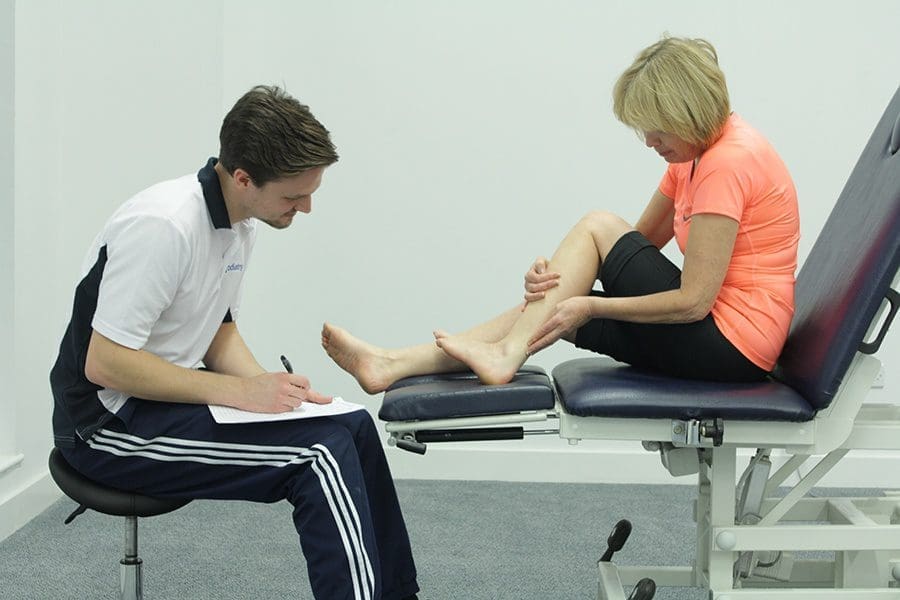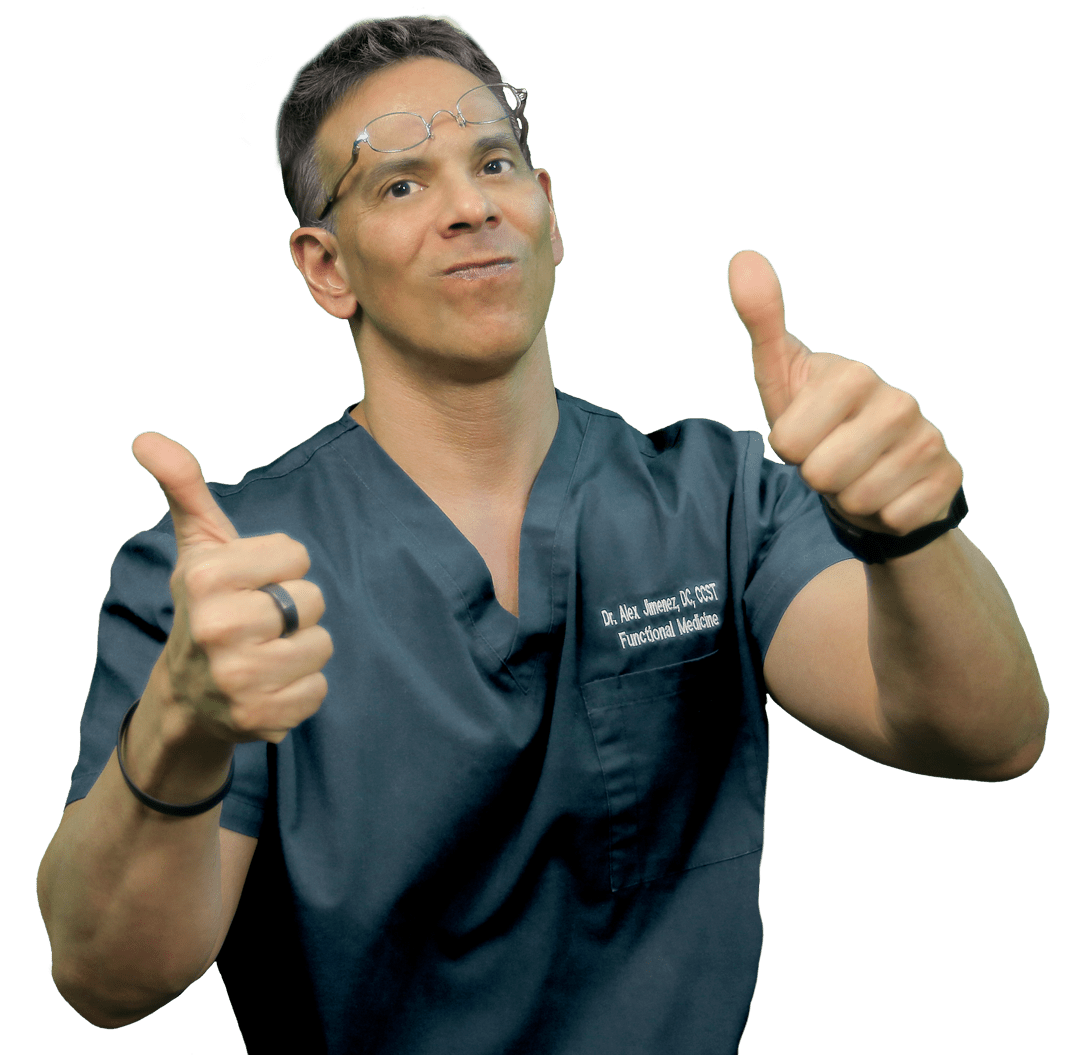These assessment and treatment recommendations represent a synthesis of information derived from personal clinical experience and from the numerous sources which are cited, or are based on the work of researchers, clinicians and therapists who are named (Basmajian 1974, Cailliet 1962, Dvorak & Dvorak 1984, Fryette 1954, Greenman 1989, 1996, Janda 1983, Lewit 1992, 1999, Mennell 1964, Rolf 1977, Williams 1965).
Clinical Application of Neuromuscular Techniques: Gastrocnemius and Soleus
Assessment of Tight Gastrocnemius and Soleus (Fig. 4.1A, B)
The patient is supine with feet extending over the edge of the table. For right leg examination the practitioner’s left hand grasps the Achilles tendon just above the heel, avoiding pressure on the tendons. The heel lies in the palm of the hand, fingers curving round it. The practitioner’s right hand is placed so that the fingers rest on the dorsum of the foot (these are not active and do not apply any pulling stretch), with the thumb on the sole, lying along the medial margin. (This position is important – it is a mistake to place the thumb too near the centre of the sole of the foot.)
Stretch is introduced by means of a pull on the heel with the left hand, taking out the slack of the muscle, while at the same time the right hand maintains the cephalad pressure via the thumb (along its entire length). A range of movement should be achieved which takes the sole of the foot to a 90° angle to the leg without any force being applied. If this is not possible (i.e. force is required to achieve the 90° angle between the sole of the foot and the leg), there is shortness in gastrocnemius and/or soleus. Further screening is required to identify precisely which (see soleus test below).
It is possible to use the (left) hand, which has removed slack from the muscles via traction, to palpate for a sense of bind, as the foot is dorsiflexed. The leg must remain resting on the table all the while and the right hand holding/palpating the muscle insertion and the heel should be placed so that it is an extension of the leg, not allowing an upward (towards the ceiling) pull when stretch is introduced. An alternative method is to have the patient seated on the table, legs outstretched, and to have her bend towards the toes with arms extended. If toe touching is possible, but toes are plantarflexed, then there is probably shortness of the gastrocnemius–soleus muscles.

Figure 4.1A Assessment or treatment of gastrocnemius and soleus. During assessment the sole of the foot should achieve a vertical position without effort once slack is taken out via traction on the heel. Treatment would involve taking the tissues to or through (acute/chronic) the identified barrier following an isometric contraction.

Figure 4.1B With the knee flexed, the same assessment is evaluating the status of soleus alone. Treatment would involve taking the tissues to or through (acute/chronic) the identified barrier following an isometric contraction.
Assessment of Tight Soleus
The method described above assesses both gastrocnemius and soleus. To assess only the soleus, precisely the same procedure is adopted, with the knee passively flexed (over a cushion, for example). If the sole of the foot fails to easily come to a 90° angle with the leg, without force, once slack has been taken out of the tissues via traction through the long axis of the calf from the heel, soleus is considered short. If the test in which the leg was straight indicated shortness of gastrocnemius or soleus, and the test in which the knee was flexed was normal, then gastrocnemius alone is short.
A screening test for soleus involves the patient being asked to squat, trunk in slight flexion, feet placed shoulder width apart, so that the buttocks rest between the legs (which face forwards rather than outwards). If the soleus muscles are normal then it should be possible to go fully into this position with the heels remaining flat on the floor. If not, and the heels rise from the floor as the squat is performed, the soleus muscles are probably shortened.
MET Treatment of Shortened Gastrocnemius and Soleus (Fig. 4.1A, B)
The exact same position is adopted for treatment as for testing, with the knee flexed over a rolled towel or cushion if soleus is being treated, and the knee straight if gastrocnemius is being treated. If the condition is acute (defined as a dysfunction/injury of less than 3 weeks’ duration) the area is treated with the foot dorsiflexed to the restriction barrier. If it is a chronic problem (longer duration than 3 weeks) the barrier is assessed and the muscle treated in a position of ease, in the mid-range, away from the restriction barrier.
Starting from the appropriate position, at the restriction barrier or just short of it, based on the degree of acuteness or chronicity, the patient is asked to exert a small effort (no more than 20% of available strength) towards plantarflexion, against unyielding resistance, with appropriate breathing (see Box 4.2). This effort isometrically contracts either gastrocnemius or soleus (depending on whether the knee is unflexed or flexed). This contraction is held for 7–10 seconds (or longer – up to 20 seconds – if the condition is chronic) together with a held breath (if appropriate).
On slow release, on an exhalation, the foot/ ankle is dorsiflexed (be sure to flex the whole foot and not just the toes) to its new restriction barrier if acute, or slightly and painlessly beyond the new barrier if chronic, with the patient’s assistance. If chronic, the tissues should be held in slight stretch for at least 10 seconds (longer would be better) in slight stretch to allow a slow lengthening of tissues. (See notes on ‘creep’ and viscoelasticity in Ch. 2.) This pattern is repeated until no further gain is achieved (backing off to mid-range for the next contraction, if chronic, and commencing the next contraction from the new resistance barrier if acute).
Alternatively, if there is undue discomfort using the agonists (the muscles being treated) for the contraction, the antagonists to the short muscles can be used by introducing resisted dorsiflexion with the muscle at its barrier or short of it (acute/chronic) followed by painless stretch to the new barrier (acute) or beyond it (chronic), during an exhalation. Use of antagonists in this way is less effective than use of the agonist but may be a useful strategy if trauma has taken place. NOTE: Figure 4.2 offers an alternative treatment position for gastrocnemius which can also be used for assessment. Flexion of the knee would allow this position to be used for treating soleus.

Figure 4.2 MET treatment position for gastrocnemius. If knee were flexed the same position would focus on treatment of soleus only.
Dr. Alex Jimenez offers an additional assessment and treatment of the hip flexors as a part of a referenced clinical application of neuromuscular techniques by Leon Chaitow and Judith Walker DeLany. The scope of our information is limited to chiropractic and spinal injuries and conditions. To discuss the subject matter, please feel free to ask Dr. Jimenez or contact us at 915-850-0900 .
By Dr. Alex Jimenez

Additional Topics: Wellness
Overall health and wellness are essential towards maintaining the proper mental and physical balance in the body. From eating a balanced nutrition as well as exercising and participating in physical activities, to sleeping a healthy amount of time on a regular basis, following the best health and wellness tips can ultimately help maintain overall well-being. Eating plenty of fruits and vegetables can go a long way towards helping people become healthy.

ADDITIONAL TOPIC: EXTRA EXTRA: Treating Back Pain
Post Disclaimers
Professional Scope of Practice *
The information herein on "Assessment and Treatment of Gastrocnemius and Soleus" is not intended to replace a one-on-one relationship with a qualified health care professional or licensed physician and is not medical advice. We encourage you to make healthcare decisions based on your research and partnership with a qualified healthcare professional.
Blog Information & Scope Discussions
Our information scope is limited to Chiropractic, musculoskeletal, physical medicines, wellness, contributing etiological viscerosomatic disturbances within clinical presentations, associated somatovisceral reflex clinical dynamics, subluxation complexes, sensitive health issues, and/or functional medicine articles, topics, and discussions.
We provide and present clinical collaboration with specialists from various disciplines. Each specialist is governed by their professional scope of practice and their jurisdiction of licensure. We use functional health & wellness protocols to treat and support care for the injuries or disorders of the musculoskeletal system.
Our videos, posts, topics, subjects, and insights cover clinical matters, issues, and topics that relate to and directly or indirectly support our clinical scope of practice.*
Our office has reasonably attempted to provide supportive citations and has identified the relevant research study or studies supporting our posts. We provide copies of supporting research studies available to regulatory boards and the public upon request.
We understand that we cover matters that require an additional explanation of how it may assist in a particular care plan or treatment protocol; therefore, to further discuss the subject matter above, please feel free to ask Dr. Alex Jimenez, DC, or contact us at 915-850-0900.
We are here to help you and your family.
Blessings
Dr. Alex Jimenez DC, MSACP, RN*, CCST, IFMCP*, CIFM*, ATN*
email: coach@elpasofunctionalmedicine.com
Licensed as a Doctor of Chiropractic (DC) in Texas & New Mexico*
Texas DC License # TX5807, New Mexico DC License # NM-DC2182
Licensed as a Registered Nurse (RN*) in Florida
Florida License RN License # RN9617241 (Control No. 3558029)
Compact Status: Multi-State License: Authorized to Practice in 40 States*
Presently Matriculated: ICHS: MSN* FNP (Family Nurse Practitioner Program)
Dr. Alex Jimenez DC, MSACP, RN* CIFM*, IFMCP*, ATN*, CCST
My Digital Business Card






 Again, I Welcome You.
Again, I Welcome You.
Comments are closed.